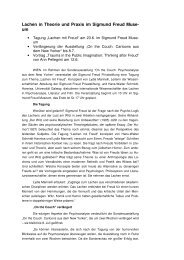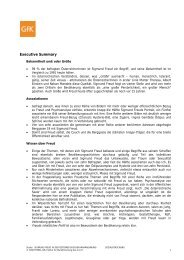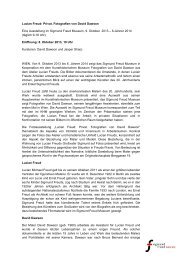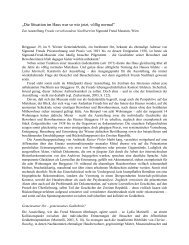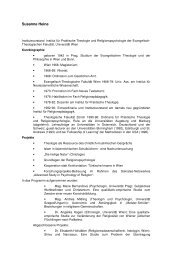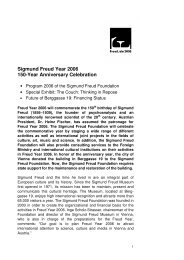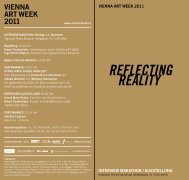Sigmund Freud-Museum | Newsletter - Sigmund Freud Museum Wien
Sigmund Freud-Museum | Newsletter - Sigmund Freud Museum Wien
Sigmund Freud-Museum | Newsletter - Sigmund Freud Museum Wien
Create successful ePaper yourself
Turn your PDF publications into a flip-book with our unique Google optimized e-Paper software.
e said in that language or any language” does not apply to art. It is the reflexive aspect of art, as a<br />
process, in which it can see itself before it proceeds, which limits the analogy of art with language.<br />
The location of the process (or how it comes to be manifested) is that shifting interface where art is<br />
both like and unlike language. The ways in which it is like language is what makes sense to you, now,<br />
hearing this, as one that knows and can identify language. Yet art, because of the agency of the artist<br />
and his or her subjective role, has properties which language – pragmatic, and potentially usable by<br />
anyone – does not and cannot have. One could say that art is like a language comprised only of<br />
language games, from which other language games are constructed. What it ‘says’ can only be said<br />
elliptically. Art as a language game, in this analogy, can be comprised of anything – like that of<br />
language, its presence as sound, or ink on a page, or photography, is arbitrary – as long as it becomes<br />
perceived as an additional game, introducing additional rules. One ‘speaks’ through the addition and<br />
elimination of games and rules, even if seemingly speaking of the world, but what one ‘says’ in the<br />
short term only seems to alter our view of that historicized compilation of language games (which is<br />
experienced, at any given moment, as one game). This is art’s elliptical quality, and what its slow<br />
circling makes visible is the mechanism of culture itself. Seen another way, we have consciousness<br />
itself made external and functioning as a concrete event (not unlike a language being made visible<br />
without loosing its transparency).<br />
In this ‘external’ state of visibility it can then become accountable. It is this aspect of accountability<br />
which gives art its political life. What I have called elsewhere ‘the questioning of the nature of art’ is<br />
precisely that act of accountability. It is a part of the creative process, when it is truly creative. Such a<br />
questioning process can only, it seems to me, manifest itself in a meaningful war within the<br />
construction of the new language game itself, and this through the comparison implicit in the alteration<br />
of something like paradigm models which a new game with new rules can potentially provide. Thus,<br />
political ‘content’ has really no effect within the slow circling of game and rule construction. Its only<br />
political effect is equivalent to a kind of message which could be cloned, essentially, without being<br />
staged as art. What its presentation as art adds to such a message is a form of institutional authority<br />
within culture. This is why art as propaganda has always looked, and functioned, the same on the<br />
political left and right. As a result, such work is doomed to be conservative because it cannot be truly<br />
critically reflexive, either externally, of its own institutional dimensions, or internally, of its own<br />
signifying operations qua art. Art is simply turned into a ‘delivery system’ of the political message.<br />
There must be a real political life to art on the deeper level of the signifying process itself: exactly<br />
those meanings produced by its own process and which tell us much about culture and ourselves,<br />
without which the activity has no social value. Alternatively we are left with the specter of art as an<br />
idealist category, one which reduces us all to passive receivers of a message, and then only the<br />
message of a short-term goal, be it for ‘politics’ or for a market. Such an activity does exist, in fact,<br />
and it is called advertising. It is pragmatic and is neither self-critical nor reflexive beyond what its<br />
pragmatism demands. It neither questions its own nature nor is it accountable. The comparison of art<br />
with advertising itself reveals the difference of a critical and even philosophical space, and that is the<br />
difference which suggests art’s real political life. Art, as a process of game-making and rule-adding,<br />
does not seem to produce knowledge in the conventional sense (as a ‘language’ it is, as I said, without<br />
a pragmatic dimension), yet the process itself shows, and in so showing it tells us something important<br />
about the world which culture constructs. As it sees itself, art sees the world, and changes it.<br />
| Joseph Kosuth<br />
Joseph Kosuth, born 1945 in Toledo, Ohio, was one of the pioneers of conceptual art, first becoming<br />
widely known through his indoor and outdoor installations at the New York Guggenheim <strong>Museum</strong> and<br />
the National <strong>Museum</strong> of Modern Art in Tokyo, among others. Currently he is working on projects for<br />
the German Bundestag in Berlin and the Hiroshima Municipal High School in Hiroshima. Joseph<br />
Kosuth lives and works in New York and Rome.<br />
Since the 1980s Joseph Kosuth has devoted much attention to the theories of <strong>Sigmund</strong> <strong>Freud</strong>. At his<br />
initiative, international artists were invited to put their work at the <strong>Sigmund</strong> <strong>Freud</strong> <strong>Museum</strong>’s disposal<br />
– later the “Foundation for the Arts, <strong>Sigmund</strong> <strong>Freud</strong> <strong>Museum</strong> Vienna” was created to further this<br />
purpose. Kosuth’s contribution, the installation “Zero & Not,” was removed at the time of the<br />
<strong>Museum</strong>’s renovation in 1996 and processed into multiples by the artist.



